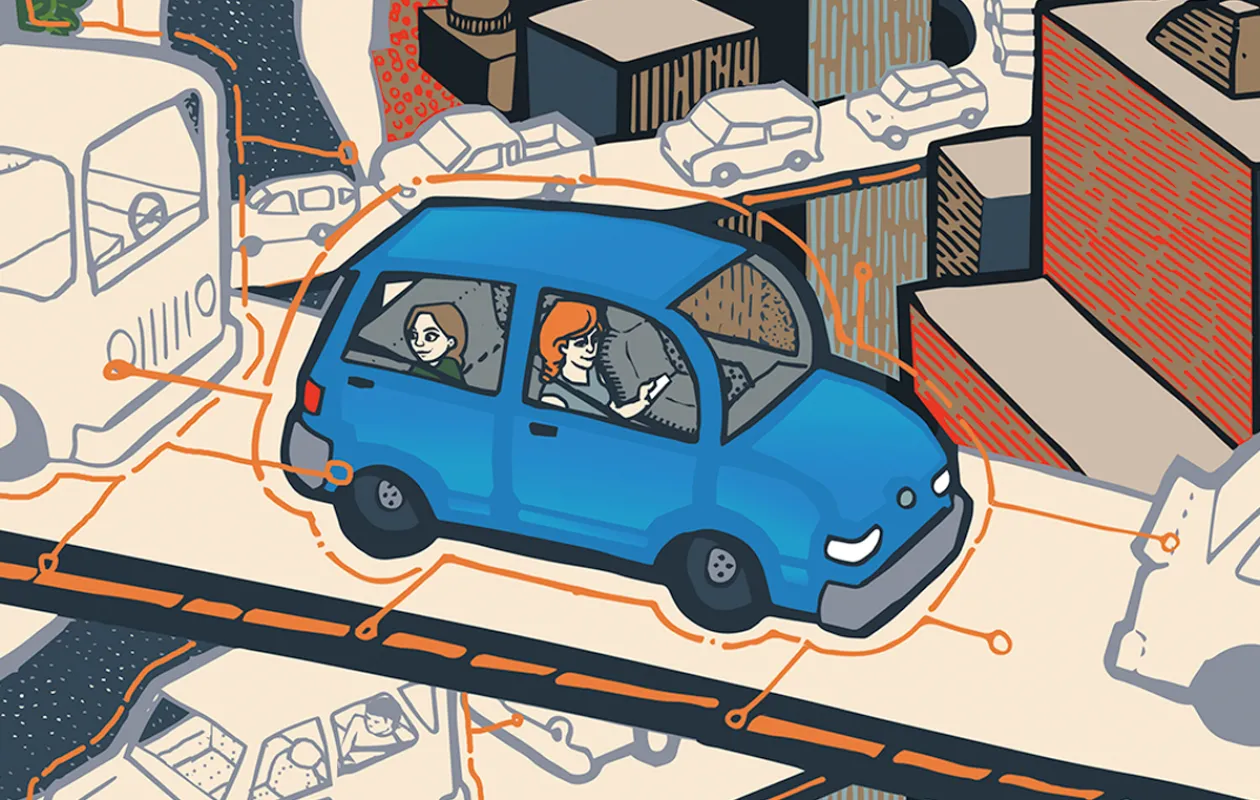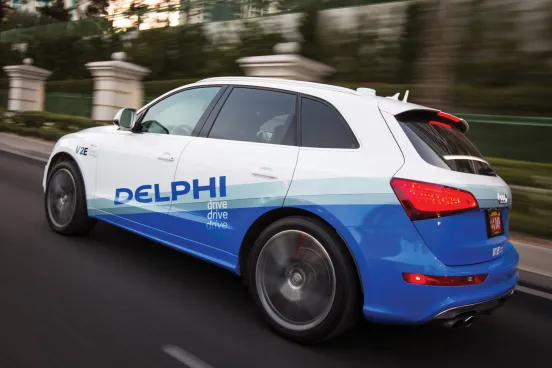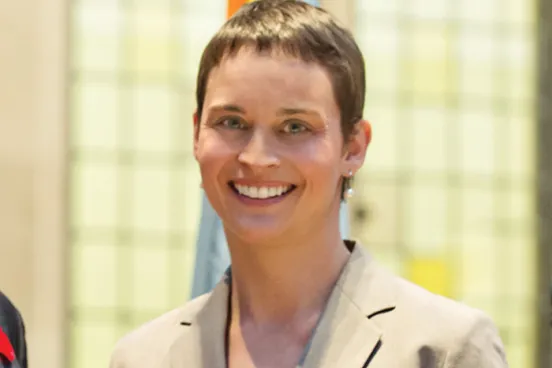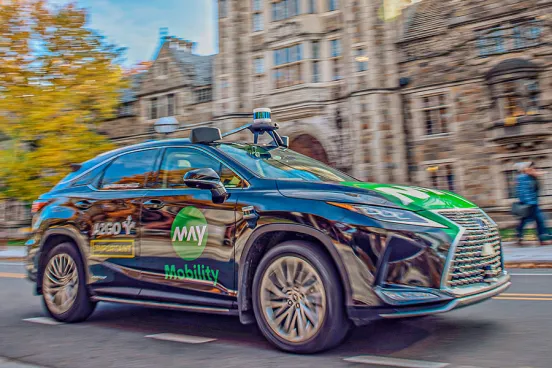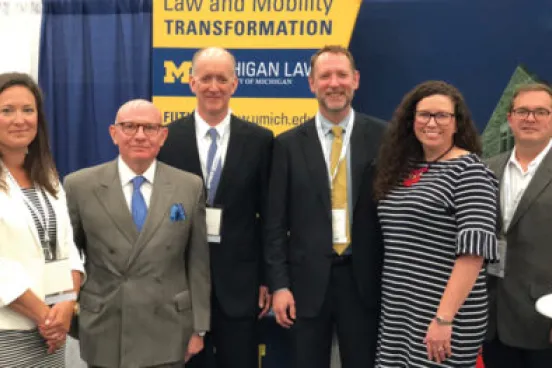In what could be the biggest transportation revolution since the horse and buggy gave way to mass production of the Model T, autonomous and connected cars are poised to take over the roadways. Exactly when it will happen is open to varying predictions, but most observers of the automotive industry believe that it is the future of daily transportation. The technology has come a long way, and it has outpaced solutions in another realm: The legal world. Now, Michigan Law is set to become the central repository for rapidly evolving legal and regulatory information involving autonomous vehicles.
In the movie Minority Report, cars drive smoothly and easily on the roadways of the future, with no drivers necessary. In Total Recall, a creepy robot drives Arnold Schwarzenegger’s character around town. Some versions of the Batmobile were self-driving, as was KITT, the talking car in the TV series Knight Rider.
These cars were fun and futuristic, and they wowed audiences at the time the movies and TV shows aired. Some of them even predicted technologies that would be featured on real cars, on actual highways.
But while the focus has been on the gadgets and sleek designs, popular culture has taken little notice of a key component of a driverless future: the legal implications. Fair enough, since it would be difficult to create a compelling narrative about whether it is legal for the Minority Report cars to cross state lines, or the liability issues raised by a crash between KITT and a car driven by a person.
In the real world, though, those issues must be addressed before driverless cars can take the rapid leap forward that many are predicting. That’s why a group of Michigan Law faculty members and students are working on a grant-funded project to survey the legal and regulatory issues that arise from automated vehicle technologies. They are working with academic and industry leaders to survey issues such as liability, insurance, privacy, intellectual property rights, and antitrust implications.
“Many places understand a piece of this, but we can really provide the big picture,” says Dan Crane, associate dean for faculty and research and the Frederick Paul Furth Sr. Professor of Law, and one of the collaborators on the project. Some legal questions involving autonomous vehicles have been answered, he says, but “what’s new is that we are thinking about these issues comprehensively.”
He cited the Law School faculty’s array of specialties, as well as interdisciplinary relationships with Michigan’s top engineering and business schools and computer science program, among the reasons that Michigan Law can become a “central repository” for information about autonomous vehicles. The Law School began offering one of the first classes in the country about the legal issues involved with driverless cars this past winter.
The environment beyond the Law Quad is supportive as well. The University’s Mobility Transformation Center—a public/private research and development partnership that is funding the Law School’s grant—last year opened Mcity, 18 acres of roads and supporting infrastructure on North Campus where connected and automated vehicles can test their road-readiness in a variety of conditions. And, of course, southeastern Michigan continues to be home to some of the largest automobile manufacturers and suppliers in the world.
“All of this helps to give the Law School a comparative advantage when addressing these issues,” says Crane, who specializes in contracts, antitrust, and intellectual property. “We can really become the focal point going forward.”
The Big Picture
Before taking a look at the more nuanced legal and regulatory issues, let’s start with an overarching legal quandary that looms above any discussion of driverless cars.
“The science is generally there, but most vehicle regulations were written before autonomous vehicles were even possible,” says Bryce Pilz, ’00, clinical assistant professor in the Law School’s Entrepreneurship Clinic, who represents tech startups in intellectual property, incorporation, and financing matters. Pilz is a collaborator on the Law School’s project. “One question that needs to be answered is, are autonomous vehicles even legal?”
The answer: Sort of. Four U.S. states (Michigan, California, Nevada, and Florida) and Washington, D.C., have passed laws allowing driverless cars. Variation exists among those five laws; Michigan’s, for instance, only provides for the testing of autonomous vehicles. Draft regulations in California might require an option for humans to operate the vehicles—drawing the ire of Google, which would prefer not to include steering wheels and brakes in its fully autonomous cars. It is unclear if autonomous cars are legal in states where regulations don’t specifically address them.
Meanwhile, the federal government is making a push to integrate the regulation of autonomous vehicles, acknowledging the likelihood that the vehicles will offer enhanced safety, efficiency, and mobility. Earlier this year, President Obama’s budget request included a 10-year, nearly $4 billion investment to “accelerate the development and adoption of safe vehicle automation through real-world pilot projects.” The funding would support programs that test connected vehicle systems in designated corridors throughout the country. Additionally, the government would work with industry leaders to ensure a “common multistate framework” for connected and autonomous vehicles.
A federal approach to regulation might be the best way to prevent a patchwork of laws and regulations that change whenever a car crosses into a new state, the researchers say. The sooner, the better, says Pilz.
“Nobody knows exactly what the regulations are going to look like and if there will be consistency from one state to another,” he says. “I think the widespread use of autonomous vehicles is going to happen faster than anyone thought, so the laws really need to be sorted out quickly.”
A study by auto industry consultant IHS Automotive forecasts total worldwide sales of self-driving cars will grow from nearly 230,000 in 2025 to 11.8 million in 2035. The study anticipates that nearly all of the vehicles in use are likely to be self-driving cars or self-driving commercial vehicles sometime after 2050. State and federal laws, the study says, “will be needed before 2020 or the lack thereof will slow the introduction of self-driving cars.”
Liability and Torts
Another issue involves crashes and liability. What happens when two autonomous vehicles crash, or when one collides with a car driven by a human? Currently, automotive risk is a combination of tort law and direct, agency-based regulation, points out Kyle Logue, the Wade H. and Dores M. McCree Collegiate Professor of Law, who specializes in the fields of torts, insurance, and tax and who is a collaborator
on the Law School project. That construct likely will be very different in a driverless world, he says.
At this stage, there are more questions than answers: How will risk be regulated? What will the new insurance structure be? Will there be a shift from individual insurance to insurance for companies that own fleets of cars? Driverless cars with crash-avoidance technology have been widely predicted to decrease fatalities and other auto accidents significantly, but what will be the effect on product liability claims when accidents do occur? Will insurance companies need to charge significantly higher rates for non-autonomous cars? Product liability allocation is state based; to what extent can the National Highway Traffic Safety Administration (NHTSA) preempt state law in establishing regulations?
Unique “joint liability” risks may arise from cooperatively developed or owned technologies, Logue says. Something similar to the common-carrier liability for bus riders could be applied, far into the future, to fleets of driverless cars thatcan be rented on-demand to consumers, he says. Pilz raises the question of whether it could be similar to vaccine liability,in which vaccine makers are shielded from lawsuits by
federal law. Students working on the Law School project are researching questions such as how liability risk will be allocated among suppliers—that is, how much risk will be allocated to the automotive company that makes the car, to the technology company that makes the algorithm saying what the car should do, to the companies that make transmitters and receivers in cars and on the road, and so on.
“It’s hard to know how this is going to affect insurers and how the risk will be allocated. This is something very important to the industry. If we move in the direction of greater manufacturer responsibility for highway accidents, it will mean a shift of auto risks from auto insurers to product-liability insurers,” Logue says, and figuring it out could slow the speed at which autonomous vehicles hit the roadways. Automakers, meanwhile, are “nervous that it will inhibit innovation,” he says.
Some developers of driverless cars could take on the liability themselves—including Volvo, which has said it will do when cars are in fully autonomous mode. The carmaker also has promised death-proof cars by 2020.
Antitrust and Standardization
Autonomous and connected vehicles may communicate through vehicle-to-vehicle (V2V),vehicle-to-infrastructure (V2I), or vehicle-to-everything (V2X) technologies. With V2V technology, wireless communication between vehicles will transmit data about speed, relative positions on the road, and other factors. With V2I, vehicles communicate with sensors on the road, traffic lights, and cameras.
Standardization of the technology will be vital, regardless of which method is used, Crane points out. “Collaboration is certainly necessary for the technology to take off,” he says. “This is a situation where standardization isn’t optional. And I don’t know if we have a standardization model for the size and complexity of this issue.”
What remains unclear is who will make this happen, which companies will gain a piece of the pie in the process, and what happens when people with patents insert themselves into the standardization process (will they horse-trade patents? Will they hide what patents they have until their favored technology is adopted?).
And, going back to tort law, Logue says that an automaker or parts supplier might try this defense if something goes wrong on a vehicle: “We did exactly what the standard says; the standard-setter should be at fault, not us.”
One option would be the establishment of a fund, along the lines of the September 11 Victim Compensation Fund—which requires compensation to be provided for any individual (or a personal representative of a deceased individual) who suffered physical harm or was killed as a result of the terrorist-related aircraft crashes of September 11, 2001, or the debris removal that took place immediately after the crashes. With standardized technology and driverless cars, Crane suggests, manufacturers could pay into a fund that would compensate people who are injured in accidents. In return, they could be immune to tort liability.
Some have suggested a federal law that creates a standardized mechanism for liability. “This could pave the way for companies to advance the technology needed to ameliorate the crushing costs of human-driven autos on our country,” argued a writer in the Vanderbilt Journal of Entertainment & Technology Law.
Another legal area in which standardization would play a role is antitrust law. The development of standards for autonomous vehicles “can be misused for anti-competitive purposes,” predicted an article by GTW Associates, a standards and trade-policy consultancy.
A recent Forbes article also sounded alarm bells about the potential for antitrust violations. “The powerful temptation for some competitors to coordinate—at the expense of their customers—may be amplified as the automobile and insurance industries are refashioned with the movement to driverless cars, given how dramatic and rapid these changes are likely to be,” the article stated. “As the Supreme Court has warned, standard setting is ‘rife with opportunities for anticompetitive activity.’”
Privacy, Security, and IP
Integrated technology will be essential in the development of a network of driverless cars that can communicate with, or at least sense the presence of, other cars. That technology is vital in the prevention of accidents, but it also creates concerns about privacy and intellectual property.
“People really want to know, is the government going to be able to track you more than it already does? What if your enemy wants to track you?” Crane says. “Once we deploy a system of real vehicle automation, will there be a computer that’s tracking all the traffic like we have with airlines? There is a tremendous potential for abuse.”
Large amounts of data will be generated and will require protections and regulation, Pilz points out. “Cybersecurity is a big concern.; There is no way to be 100 percent secure, but what can be done; to protect as much personal information as possible?”
Security also presents a risk question, says Logue. If a criminal or terrorist group causes mayhem, and such an attack is foreseeable, “it’s conceivable” that manufacturers that control how easily the system can be hacked could be liable, he says. He points out, however, that some manufacturers, such as the gun industry, have successfully raised defenses in the past to limit their liability when sued for the criminal use of their products.
The Michigan Law team is looking at current laws on cybersecurity and how they relate to cooperatively produced data, and cooperatively owned or governed infrastructures, such as a system called; the Security Credential Management System (SCMS) that is being created by NHTSA and its partners.
SCMS is a system for ensuring trusted and secure V2V and V2I; communications. The system, according to NHTSA, would employ “highly innovative methods, encryption, and certificate management techniques to address the challenging task of ensuring trusted communications between entities that previously have not encountered each other—but also wish to remain anonymous (as is the case when vehicles/drivers encounter each other on the road).”
Many observers from civil-liberties and consumer organizations have expressed concerns about Big Brother not only watching drivers in real time, but also keeping track of their movements longterm with the use of data collection. In the end, though, will the public care?
As a recent article in The Washington Post predicts, “Self-driving; cars will make it easier for the authorities to track you everywhere you go. But the benefits of self-driving cars are likely to be so enormous that American consumers will sign up in droves, regardless of the privacy implications.”
says Dan Crane, associate dean for faculty and research and the Frederick Paul Furth Sr. Professor of Law, and one of the collaborators on the project. Some legal questions involving autonomous vehicles have been answered, he says, “but what’s new is thatMany places understand a piece of this, but we can really provide the big picture,
The Future
The American mythology of the open road—and, specifically, driving on it—maintains a powerful hold on the nation’s psyche. The same is true in many other countries, where car ownership is a status symbol or an emblem of freedom. Given that, will people ever be willing to give up car ownership for the freedom and cost-savings of ordering from a fleet of driverless cars, whenever and wherever they want? An article in Car and Driver, perhaps not surprisingly, expressed skepticism. “If you’re reading this magazine,” the article stated, “we assume that the notion of a self-driving car is no more appealing to you than a magazine titled Needle and Plague.”
Opinion polls vary in regard to the public’s willingness to accept autonomous vehicles, with many people worried that fully driverless vehicles are unsafe. Even so, numerous automated features already are widely available in automobiles and accepted by consumers, such as electronic stability control, adaptive cruise control, and automated parallel parking (see sidebar about NHTSA’s classification system). And regardless of public opinion, fully autonomous vehicles are making progress every day: Consider Google’s and Delphi’s cross-country driverless car tests, Tesla’s hands-free driving route between Seattle and San Francisco, Ford’s successful tests at Mcity in notoriously difficult snowy conditions, and ride-hailing app Lyft’s and General Motors’s plan to develop an on-demand network of self-driving cars. Audi, Mercedes-Benz, Nissan, and many other automakers and technology companies also are making significant breakthroughs.
As the technology continues to advance, Crane says, another important issue still needs to be resolved: When it comes to driverless cars, what is the commodity and what is the value? Consider the example of IBM in the 1980s, when the company decided to outsource personal computer microprocessors to a little company and the operating system to another small company; today, we know them as Intel and Microsoft.
“The car itself could end up being just the commodity,” Crane says. “Will people continue to have an emotional connection to their cars and want to own them? Or will the companies that figure out how to deliver cars to your door and control the transportation network—will that be the value?”
In addition to the thorny legal issues, he says, “everyone,” including the team at Michigan Law, “is trying to figure out who will own this, and what the valuable part will be.”
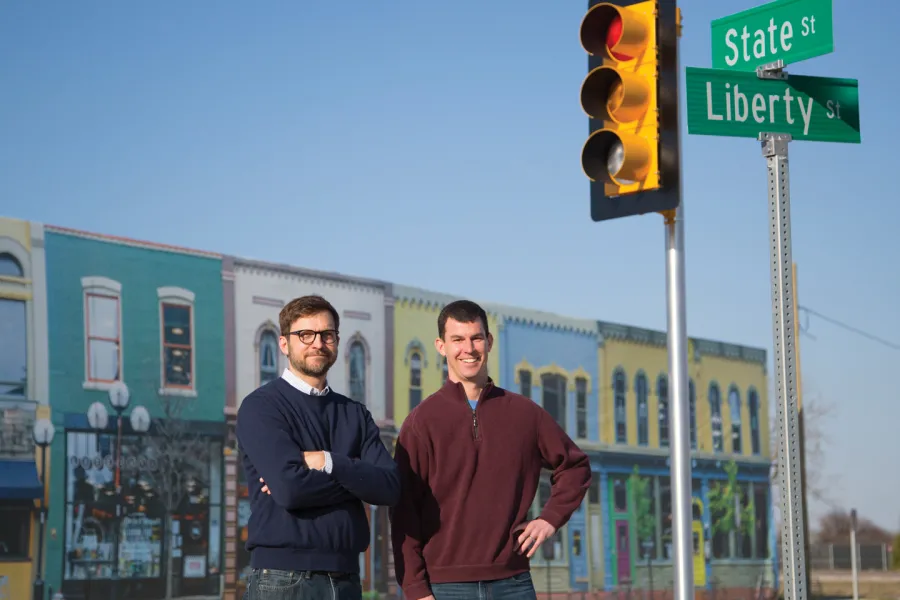
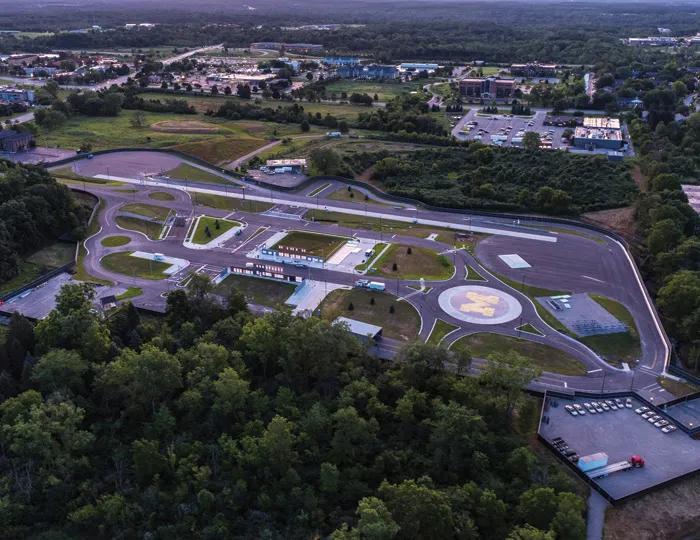
Moving Forward
U-M is fast becoming a hub of the self-driving and connected vehicle world, with the College of Engineering and the Transportation Research Institute (UMTRI) making key advancements in the development of automated vehicles. Researchers at the College of Engineering, for instance, are working with corporate partners to develop and test autonomous vehicles at Mcity, the University’s simulated city for driverless and connected technology operated by the U-M Mobility Transformation Center (MTC). They specialize in algorithms that allow the vehicles to make and use maps to better understand and know their surroundings across the full spectrum of when it’s sunny and clear to when it’s snowy and tougher to navigate.
MTC is a public-private partnership among industry, government, and academia. Mcity is open to any user, but priority is given to MTC’s industry partners, as well as U-M faculty and students.
Other schools and colleges within the University—including the Law School—also are exploring such issues as societal impact, consumer behavior, new business models, and more, working with MTC. Current and anticipated partners include the Medical School, the Stephen M. Ross School of Business, the Gerald R. Ford School of Public Policy, the A. Alfred Taubman College of Architecture and Urban Planning, the School of Information, the Energy Institute, and more.
“MTC highlights the interdisciplinary strengths of U-M,” says Prof. Huei Peng, director of MTC. “Our goal is to draw on expertise across campus, and from our industry and government partners, to help lead a revolution in mobility through connected and automated transportation.”
—Henry Liu, a U-M civil engineering professor who is testing a network of sensors and radio transmitters.When we have a system that can use data to alert drivers, the next logical step is to begin removing the driver from the equation. This will start in the near future with assist functions—for example, your car could automatically brake to avoid a dangerous situation. It’s part of a longer evolution toward autonomous vehicles. And it’s only a matter of time.
NHTSA’s Five Levels of Vehicle Automation
| Level 0 | No automation. The driver is in complete and sole control of the primary vehicle controls—brake, steering, throttle, and motive power—at all times. |
| Level 1 | Function-specific automation. Automation at this level involves one or more specific control functions. Examples include electronic stability control or pre-charged brakes, where the vehicle automatically assists with braking to enable the driver to regain control of the vehicle or stop faster than possible by acting alone. |
| Level 2 | Combined function automation. This level involves automation of at least two primary control functions designed to work in unison to relieve the driver of control of those functions. An example of combined functions enabling a Level 2 system is adaptive cruise control in combination with lane centering. |
| Level 3 | Limited self-driving automation. Vehicles at this level of automation enable the driver to cede full control of all safety-critical functions under certain traffic or environmental conditions and in those conditions to rely heavily on the vehicle to monitor for changes in those conditions requiring transition back to driver control. The driver is expected to be available for occasional control, but with sufficiently comfortable transition time. The Google car is an example of limited self-driving automation. |
| Level 4 | Full self-driving automation. The vehicle is designed to perform all safety-critical driving functions and monitor roadway conditions for an entire trip. Such a design anticipates that the driver will provide destination or navigation input, but is not expected to be available for control at any time during the trip. This includes both occupied and unoccupied vehicles. |
Forecast for a Driverless Future
| 2018 | First fully autonomous Tesla is expected to be introduced (approved by 2021); Google plans to have driverless cars hit the market. |
| 2020 | 10 million self-driving cars will be on the road by 2020, according to a report from BI Intelligence; Ford, Nissan, and Toyota expect to have fully autonomous vehicles on the market. |
| 2025 | 20 million autonomous vehicles will be on the road by 2025, according to a report by Juniper Research. Driverless cars will be used all around the world, according to predictions made by the U.S. secretary of transportation. |
| 2030 | The Uber fleet will be driverless, the ride-hailing company has predicted. Truly autonomous cars will populate roadways by 2028-2032, according to the Insurance Information Institute. |
| 2035 | Self-driving cars may comprise a quarter of worldwide auto sales, according to a Boston Consulting Group study. |
| 2040 | Autonomous vehicles will account for up to 75 percent of cars on the road, according to members of the engineering professional association IEEE. |
Adapted from www.driverless-future.com and other sources.


